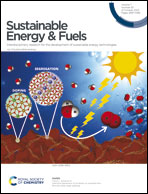Ti-decorated C30 as a high-capacity hydrogen storage material: insights from density functional theory†
Abstract
Employing density functional theory, we explore the hydrogen storage proficiency of titanium-decorated fullerene C30, an allotrope of carbon that comprises pentagonal and hexagonal rings. Titanium is bonded strongly on the hexagonal ring of C30 with a binding energy of −3.48 eV due to charge transfer from the Ti 3d orbital to the C 2p orbital of C30. A single C30 could hold 4 Ti atoms, where each Ti atom can hold 5 molecules of H2 reversibly, with an average adsorption energy of −0.50 eV and average desorption temperature of 368 K leading to a storage capacity of 6.76 wt%, higher than the target set by the US D.o.E. As per Bader charge portioning, 1.52e charge gets transferred from Ti to C30 which is responsible for strong bonding of Ti. The interplay between Ti and hydrogen is explained through Kuba's interaction which is defined as a charge donation from σ orbitals of hydrogen to the vacant 3d orbital of Ti and a subsequent back transfer of charges from the filled 3d orbital of Ti to the σ* orbital of hydrogen. The structural integrity of the system remained intact at room temperature as verified through ab initio molecular dynamics simulations, and the presence of a metal diffusion barrier of −2.75 eV can prevent metal–metal clustering. The aforementioned features of the material infer that Ti-decorated C30 is a stable, practically viable, 100% recyclable, and efficient hydrogen storage system.



 Please wait while we load your content...
Please wait while we load your content...